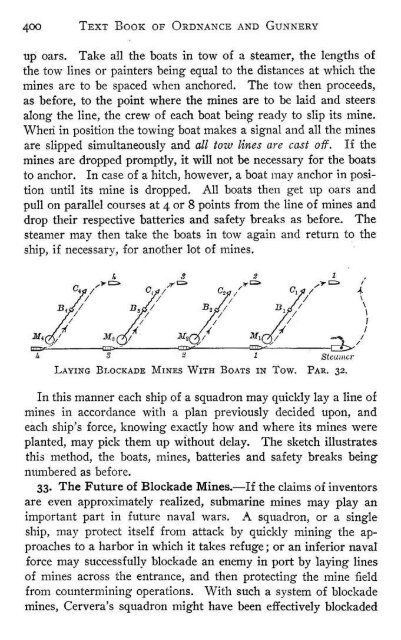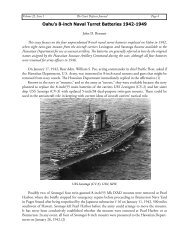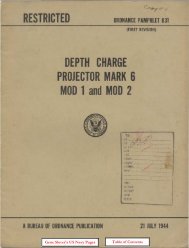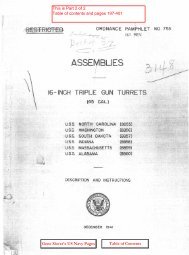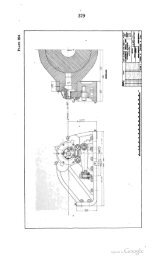and firing mechanism in a separate bl10y called a " contact buoy ...
and firing mechanism in a separate bl10y called a " contact buoy ...
and firing mechanism in a separate bl10y called a " contact buoy ...
Create successful ePaper yourself
Turn your PDF publications into a flip-book with our unique Google optimized e-Paper software.
400 TEXT BOOK OF ORDNANCE AND GUNNERY<br />
up oars. Take all the boats <strong>in</strong> tow of a steamer, the lengths of<br />
the tow l<strong>in</strong>es or pa<strong>in</strong>ters be<strong>in</strong>g equal to the distances at which the<br />
m<strong>in</strong>es are to be spaced when anchored. The tow then proceeds,<br />
as before, to the po<strong>in</strong>t where the m<strong>in</strong>es are to be laid <strong>and</strong> steers<br />
along the l<strong>in</strong>e, the crew of each boat be<strong>in</strong>g ready to slip its m<strong>in</strong>e.<br />
Wheri <strong>in</strong> position the tow<strong>in</strong>g boat makes a signal <strong>and</strong> all the m<strong>in</strong>es<br />
are slipped simultaneously <strong>and</strong> all tow l<strong>in</strong>es are cast off. If the<br />
m<strong>in</strong>es are dropped promptly, it will not be necessary for the boats<br />
to anchor. In case of a hitch, however, a boat may anchor <strong>in</strong> position<br />
until its m<strong>in</strong>e is dropped. All boats then get up oars <strong>and</strong><br />
pull on parallel courses at 4 or 8 po<strong>in</strong>ts from the l<strong>in</strong>e of m<strong>in</strong>es <strong>and</strong><br />
drop their respective batteries <strong>and</strong> safety breaks as before. The<br />
steamer may then take the boats <strong>in</strong> tow aga<strong>in</strong> <strong>and</strong> return to the<br />
ship, if necessary, for another lot of m<strong>in</strong>es.<br />
In this manner each ship of a squadron may quickly lay a l<strong>in</strong>e of<br />
m<strong>in</strong>es <strong>in</strong> accordance with a plan previously decided upon, <strong>and</strong><br />
each ship's force, know<strong>in</strong>g exactly how <strong>and</strong> where its m<strong>in</strong>es were<br />
planted, may pick them up without delay. The sketch illustrates<br />
this method, the boats, m<strong>in</strong>es, batteries <strong>and</strong> safety breaks be<strong>in</strong>g<br />
numbered as before.<br />
33. The Future of Blockade M<strong>in</strong>es.-If the claims of <strong>in</strong>ventors<br />
are even approximately realized, submar<strong>in</strong>e m<strong>in</strong>es may play an<br />
important part <strong>in</strong> future naval wars. A squadron, or a s<strong>in</strong>gle<br />
ship, may protect itself from attack by quickly m<strong>in</strong><strong>in</strong>g the approaches<br />
to a harbor <strong>in</strong> which it takes refuge; or an <strong>in</strong>ferior naval<br />
force may successfully blockade an enemy <strong>in</strong> port by lay<strong>in</strong>g l<strong>in</strong>es<br />
of m<strong>in</strong>es across the entrance, <strong>and</strong> then protect<strong>in</strong>g the m<strong>in</strong>e field<br />
from counterm<strong>in</strong><strong>in</strong>g operations. With such a system of blockade<br />
m<strong>in</strong>es, Cervera's squadron might have been effectively blockaded


